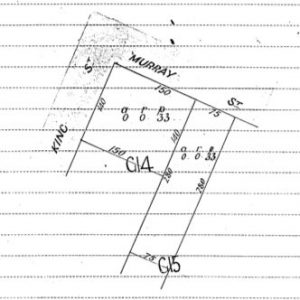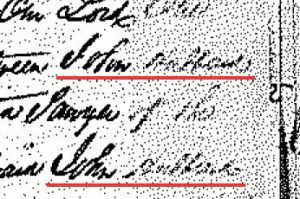As a would-be historian, I am always torn between my desire to share the information I have collected and the desire to find that one final piece of the puzzle that will complete the story I want to tell. Most of the time, that final piece is not— and may never be— there, but what to do then? Should I hoard away what I have so far, or publish and be damned?
If this is not your first reading of this page and what you are reading is different to what you recall, it means I have found some new evidence and re-written accordingly. It is why I chose a weblog to write up my material in the first place.
If the original Dyson family in Western Australia was associated with any one place in Western Australia (other than the eponymous swamp in present-day Shenton Park) it was with Dyson’s Corner, in the town of Perth. One slight problem: there were two Dyson’s Corners, and the only element they possessed in common (apart from the residency of a family called Dyson) was that they were both located (but on different street-corners) in Murray Street, on the unfashionable northern side of the town.

The first Dyson’s Corner was a parcel of land on the south side of Murray Street and the east of King street.
James Dyson, sawyer and timber merchant, finally came into formal ownership of the land on 24 January 1848, but he might have been in occupation much earlier than this, as a renter, possibly since his arrival in the colony back in 1841.
The first European “owner” of this land was a mysterious figure called Charles Brown. He was allocated these blocks in 1840, but only the following year he announced he was planning to leave the colony. As I can find nothing further about him (other than that he was possibly a member of the Methodist congregation, was known for his fruit trees, and owned other parcels of land in the city) I assume he left some time after that.
James Dyson paid the sum of £12 for the property in 1848. His neighbours were William Ward, a brick-maker, (and foundation member of the Sons of Australia Benefit Society) also John Chipper, the town bailiff. The deed of transfer was witnessed by the colonial chaplain, the Rev. F. B. Wittenoom, who was also Justice of the Peace. But who did he buy the property from? There in lies the question.
Tracing early title deeds in Western Australia is difficult and expensive. Far be it for me to begrudge a professional historian being paid a very large sum of money to look up a private database for five minutes, but the resultant digital copies you receive, also at great cost for each document you request, were obviously made years ago on very sub-standard equipment. Here is the name of the person Dyson bought the “corner” from as it appears in my document:
John ? was a sawyer, as was Dyson. Were they business partners? When did John ? buy the property, was it from good ole Charlie Brown? Is that surname Stafford, Hollands, Hutton, or something else entirely?
Its not Stanton, which is a shame, as John Stanton (1797-1877), an early councillor on the Perth town trust, a prominent papist, retired soldier, policeman and barrel-maker would have a documented altercation with Dyson in a couple of years time.

It would be nice to know exactly what the argument was about. Stanton grazed cattle within the Perth jurisdiction. Dyson provided pasturage and water for the Perth herd on his property at Dyson’s Swamp.
A year before Dyson threatened Stanton, on the night of 2nd August 1852— a Monday evening— Dyson created some sort of disturbance in the street that also ended up in court. A month later, his neighbours right across the road, Stephen Hyde and wife Hannah decided to sell up. If the two events are linked, this was a sad ending to a long association. This couple had been witnesses at Dyson’s marriage ten years before. Maybe they did not approve of how he was treating his first wife now? Just to add a little spice to the mix, in September, Mrs Hyde was convicted and fined for assaulting a Mrs Staunton. Was this Staunton the mis-spelled wife of John? When John Stanton died in 1877, Dyson’s probable business rival Benjamin Mason (whose son had been shot by Dyson’s son) was one of his executors.
Hyde (then a bricklayer) had tried to sell up previously in September 1850 (not long after the first convicts arrived). Changing his mind, he instead applied for the licence to turn his premises into a tavern, which he named “The Vine“. Hyde eventually sold up to a man named Henry Alexander Towton, a former Parkhurst boy (forerunner to the convicts) who had well and truly made good. After the Hyde family had departed for South Australia in early October, Towton re-named the establishment the “No-Place Inn“.
Towton’s son was born there the very same month. George Towton grew to be a famous horse trainer in the colony. He was present when one of Dyson’s own grand-children was killed in a racing accident in 1901. After George Towton died in 1906, Dyson’s son Septimus married his widow, but it was not a successful union.
There are no contemporary images of Dyson’s Corner (that I know of), but there is of the No Place Inn. They were probably a similar style of construction. However, Dyson’s dwelling had two stories and was described thusly:—
A first class 2-storey House, containing Shop and good Cellerage, Bakehouse and Oven ; also a 4-roomed Cottage, good Stable and Kitchen, and Shed to stable 4 horses ; fine Well of Water and a trellis.”
The Western Australian Times (Perth, WA : 1874-1879) Tuesday 27 March 1877 page 3
The four-roomed cottage had come with some additional land adjacent to Dyson’s corner that was purchased at some stage after 1869.
In 1874 the whole property was mortgaged for the sum of £500 advanced to him by members of the Stone family through the Western Australian Bank. What ever the scheme this money was required for did not pay off, so the Corner and most of his other assets, including Dyson’s Swamp, had to be sold three years later.

By 1883 James Dyson’s second marriage to Mrs Jane Edwards was well and truly over, and he had to move into the residence of his eldest surviving son Joseph, located on the corner of Murray Street and William Street. This was the second Dyson’s Corner. Whether James cast out Jane, or her step-son refused to receive her in his home, or Jane herself desired to be rid of the lot of them is not clear, but she went to work for John Liddelow, a general dealer and butcher as a housekeeper in his premises just a bit further down the road on the corner of Murray Street and Barrack Street. Liddelow was a social acquaintance, if not a friend, of her former husband, and might have thought he was doing someone a favour giving her a job. It would be a decision he would regret.

The original Dyson’s Corner on the corner of Murray and King Street, post-Dyson ownership — continued a strange intersection with its former occupier’s fortunes. That will be the subject of part two.





Leave a Reply